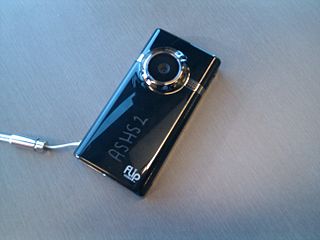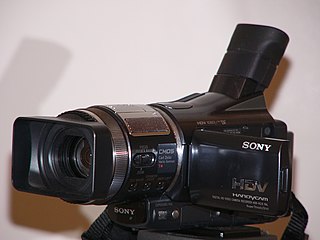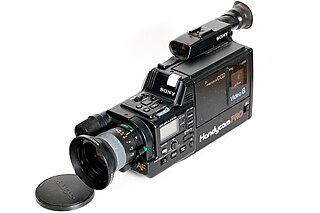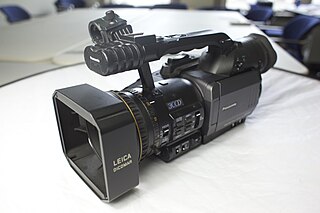
Digital video is an electronic representation of moving visual images (video) in the form of encoded digital data. This is in contrast to analog video, which represents moving visual images in the form of analog signals. Digital video comprises a series of digital images displayed in rapid succession.

A digital camera is a camera that captures photographs in digital memory. Most cameras produced today are digital, largely replacing those that capture images on photographic film. Digital cameras are now widely incorporated into mobile devices like smartphones with the same or more capabilities and features of dedicated cameras. High-end, high-definition dedicated cameras are still commonly used by professionals and those who desire to take higher-quality photographs.

DV refers to a family of codecs and tape formats used for storing digital video, launched in 1995 by a consortium of video camera manufacturers led by Sony and Panasonic. In the late 1990s and early 2000s, DV was strongly associated with the transition from analog to digital desktop video production, and also with several enduring "prosumer" camera designs such as the Sony VX-1000. DV is sometimes referred to as MiniDV, which was the most popular tape format using a DV codec during this time.

Digital8 is a consumer digital recording videocassette for camcorders based on the 8 mm video format developed by Sony, and introduced in 1999.

A camcorder is a self-contained portable electronic device with video and recording as its primary function. It is typically equipped with an articulating screen mounted on the left side, a belt to facilitate holding on the right side, hot-swappable battery facing towards the user, hot-swappable recording media, and an internally contained quiet optical zoom lens.

A video camera is an optical instrument that captures videos. Video cameras were initially developed for the television industry but have since become widely used for a variety of other purposes.

The 8mm video format refers informally to three related videocassette formats. These are the original Video8 format and its improved successor Hi8, as well as a more recent digital recording format known as Digital8. Their user base consisted mainly of amateur camcorder users, although they also saw important use in the professional television production field.

HDV is a format for recording of high-definition video on DV cassette tape. The format was originally developed by JVC and supported by Sony, Canon, and Sharp. The four companies formed the HDV Consortium in September 2003.

A digital single-lens reflex camera is a digital camera that combines the optics and the mechanisms of a single-lens reflex camera with a digital imaging sensor.
Progressive segmented Frame is a scheme designed to acquire, store, modify, and distribute progressive scan video using interlaced equipment.

The Sony HDR-HC1, introduced in mid-2005, is the first consumer HDV camcorder to support 1080i.

Sony 3CCD-VX3 was a Hi-8 camcorder noteworthy for being the first to feature dichroic (prismatic) imaging. It was released to the North American market in 1992 at a street cost of about US$3500. The PAL version as well as the Japanese version had the model name CCD-VX1.

Sony Corporation produces professional, consumer, and prosumer camcorders such as studio and broadcast, digital cinema cameras, camcorders, pan-tilt-zoom and remote cameras.
The Sony DCR-VX1000 was a DV tape camcorder released by Sony in 1995, replaced by the DCR-VX2000 in 2000 and the DCR-VX2100 in mid 2003.
General Imaging was a manufacturer of digital cameras headquartered in Torrance, California, established in 2006 by Hiroshi "Hugh" Komiya, a former executive of Olympus Corporation. General Imaging sold their cameras internationally under the General Electric name, used under license. General Imaging was licensed to manufacture and sell their cameras under the AgfaPhoto name in Japan. On October 5, 2015General Imaging filed for bankruptcy.
A 3D camcorder can record 3D video.
The DSR-570 is a digital format camcorder manufactured by Sony in Japan. It is based on the DVCAM format developed by Sony. It utilizes three 2/3 inch CCDs which are natively in the 16:9 format. The large CCDs achieve a 570,000 pixel density and over 800 TV lines in 16:9 mode. Due to the CCDs Hyper Gain option they are extremely sensitive in less than favorable lighting situations; that may be as dim as 0.25 lx. The DSR-570 is intrinsically different from most camcorders because of its hybrid capabilities. The camcorder, along with several other cameras in its family line, contain the 26-pin CCU port. This is unorthodox when compared with its successors and peers. In most cases a studio camera equipped with TRIAX or a CCU would not contain a VTR, but the DSR-570 did. A camcorder, which typically would contain a VTR, would not contain the ports traditionally associated with studio cameras. The DSR-570 married the two together in one package. Due to its flexibility, the DSR-570 has widely been used for local news stations both in the US and in Europe.

The Panasonic AG-DVX100 was released in October 2002. Its 60Hz version was the first consumer-affordable digital camcorder capable of recording video at 24 progressive frames per second.














